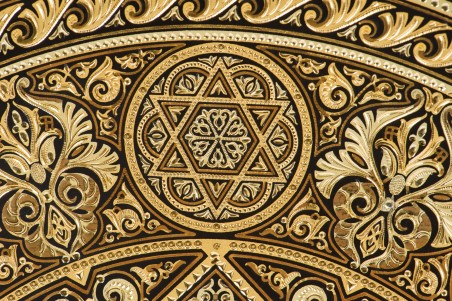

Toledo, set on the banks of the Tagus River, is a city that delights and charms with its rich artistic and cultural heritage. Its narrow stone streets, imposing walls and historic palaces testify to centuries of history and artistic influences. It is here that the past and present merge into a timeless blend of inspiration, offering contemporary artists a unique opportunity to immerse themselves in old traditions and draw inspiration for their works.
The famous ‘City of three cultures‘, so called because of the fascinating mixture of styles that testifies to the coexistence of three different religions over the centuries: Jewish, Islamic and Christian, is currently known worldwide not only for its wonderful history and its relationship with art, but also for its ‘steel’.
Although much has been written about it, it is hard to know exactly when the manufacture of cutting weapons began in this city, even if many historians claim that it is as old as the city itself. In fact, the fame of Toledo steel has its roots in the mastery of the use of tempering by Toledo craftsmen.
Despite having no specific technical knowledge, they were able to control the very high temperatures applied to steel in the manufacture of swords in ancient times. “The secret of tempering” has been guarded with great diligence over the years by the master swordsmen of Toledo and has been handed down from generation to generation until the present day, making Acero de Toledo and its sword production a worldwide reference.
Just think that the mastery of Toledo craftsmen is so renowned that when digital special effects did not yet exist, many Hollywood directors entrusted Toledo blacksmiths with the manufacture of swords and other forged objects to be used on the sets of their films.
Several of them were selected to create the swords used in the famous ‘Lord of the Rings’ film trilogy. This global award underlines their expertise and prestige in the field of artistic metallurgy.
A visit to the sword makers’ workshops is a must for anyone planning a trip to Toledo: it is a fascinating experience that allows you to immerse yourself in the ancient techniques of metalwork and to appreciate the dedication and skill of the craftsmen. The synergy between past and present is evident in these workshops, where ancient tools and centuries-old traditions mingle with the creativity and innovation of contemporary master craftsmen.
A visit to the workshops of the swordsmiths is a must for anyone planning a trip to Toledo: it is a fascinating experience that allows you to immerse yourself in the ancient techniques of metalwork and to appreciate the dedication and skill of the artisans skilled in damascening: this is an ancient artistic engraving technique used to decorate metal objects, especially weapons such as swords, daggers and armor. This technique has been practiced in Toledo, Spain, since the 8th century and has gained a considerable reputation for its craftsmanship and beauty. Damascening, handed down from generation to generation, can be admired in many shops in Toledo and its designs have been a source of inspiration for many other types of art.
The synergy between past and present is evident in these workshops, where ancient tools and centuries-old traditions mingle with the creativity and innovation of contemporary master craftsmen.
The great beauty of Toledo does not end with the manufacture of swords. The city is also home to a vast collection of artworks ranging from Renaissance paintings to mediaeval sculptures, testimony to the rich artistic history of the region. Works by masters such as El Greco, whose distinctive and visionary style influenced generations of later painters, continue to exert a timeless fascination on contemporary artists visiting the Spanish city.
The mannerist painter, originally from Crete, moved to Toledo in the 16th century and lived there for several years of his life, now bequeathing the town a valuable house-museum. Here he developed a unique style characterized by bold colors, elongated forms and an emotional representation of his subjects. El Greco´s influence is reflected in the works of many artists including two of the greatest painters in the history of art: Diego Velázquez and Vincent van Gogh.
Velázquez, the celebrated court artist of 17th century Spain, was heavily influenced by El Greco during his time in Toledo. Although Velázquez developed a distinctive style all his own, the influence of El Greco is evident in his bold manipulation of light and innovative use of perspective. Velázquez’s interest in atmosphere and emotion, which characterize many of his most famous works, can be attributed in part to his exposure to El Greco’s work during his years in Toledo.
Vincent van Gogh, the famous Dutch post-impressionist painter, was also deeply influenced by El Greco. Van Gogh, fascinated by the unique vision and emotional depth of the artist’s works, carefully studied his work and assimilated the elements into his own personal style. Van Gogh’s bold use of color and energetic brushstrokes reflect the inspiration he drew from El Greco’s style, demonstrating his lasting impact on modern art.
Toledo is more than just a Spanish city; it is a crossroads of art, history and culture that continues to inspire and influence artists today. Through its ancient craft traditions and timeless works of art, the city reminds us of the importance of connecting with the past to nurture creativity and innovation in the present.






